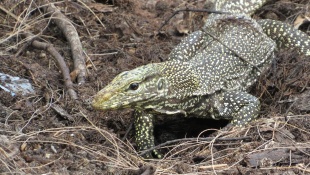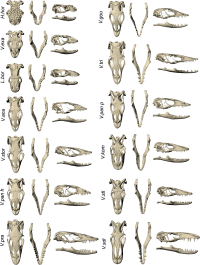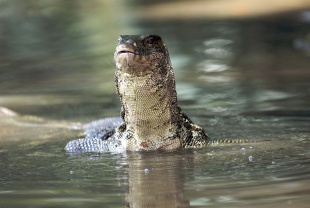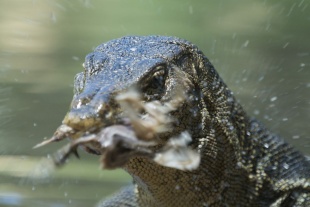MONITOR LIZARDS
Monitor lizards are lizards in the genus Varanus, the only extant genus in the family Varanidae. Known as varanids, they are native to Africa, Asia, and Oceania and have been introduced to some places in the Americas. About 80 species are recognized. They range in length and weight from tiny short-tailed monitors — which are 20 centimeters long and weigh 20 grams — to the Komodo dragons — which are up to three meters long and weigh up to 54 kilograms. Monitors occupy a wide range of habitats, and different species can be primarily surface dwelling, burrowing, arboreal (live mainly in trees), or saxicolous ( living on or among rocks) . Monitors can also be primarily aquatic or marine, though like all, reptiles, they must lay their eggs on land. [Source: Wikipedia +, Jennifer C. Ast, Animal Diversity Web (ADW) /=]
It is not exactly clear where the English name “monitor lizards” — "monitors" for short — comes from but it may have originated from the occasional habit of varanids to stand on their two hind legs and to appear to "monitor" their surroundings, or maybe from their supposed attribute of "warning people of the approach of venomous animals". These explanations, however, postdate Linnaeus, who gave the scientific name Lacerta monitor to the Nile monitor in 1758, which may have been based on a mistaken idea by Linnaeus that the German word Waran (borrowed from Arabic) was connected to warnen (to warn), leading him to incorrectly Latinize it as monitor ('warner', 'adviser'). +
In Southeast Asia monitor lizards are common. Austronesian languages spoken there numberous of slightly related local names for them, including biawak in Malaysia and Indonesia, bayawak in the Philippines and binjawak in Java. In Australia, they are called goannas, which is derived from the Spanish word iguana. Early European settlers in Australia mistook goannas for iguanas, which are lizards from the Americas. Other names for monitor lizards include hokai (Solomon Islands); halo (Cebu); galuf (Micronesia); butaan (Luzon); alu (Bali); hora (Komodo group of islands); phut (Burmese); umbu (Tamil in southern India); talagoya (in Sinhala in Sri Lanka); uda (Punjabi); gui xaap (Assamese); goshaap (Bengali); goh (Hindi) and godhā (Sanskrit). +
Monitor lizards are featured in ancient Australian and Indian art. They are also prevalent in the folklore and superstitions of the place where they are found. Some species of Varanus supply skins used to make leather and body parts used for traditional medicines. Monitor lizardss are eaten by people in Australia, Africa and Asia. Some Aboriginals in Australia love them. Some species appear are threatened by habitat destruction but for the most part they are hardy animals and do okay where humans are presents, sometimes scavenging trash and carrion. Overall, there has been a very low success rate captive breeding monitor lizards.
RELATED ARTICLES:
BIGGEST AND MOST COMMON MONITOR LIZARDS: ASIAN WATER AND BENGAL MONITORS factsanddetails.com
GOANNAS (MONITOR LIZARD) SPECIES OF AUSTRALIA ioa.factsanddetails.com
MONITOR LIZARDS OF NEW GUINEA: SPECIES, CHARACTERISTICS, BEHAVIOR AND REPRODUCTION ioa.factsanddetails.com
REPTILES: TAXONOMY, CHARACTERISTICS, THREATENED STATUS factsanddetails.com
LIZARDS: CHARACTERISTICS, SENSES, ODDITIES factsanddetails.com
KOMODO DRAGONS: CHARACTERISTICS, HABITAT, SENSES, MOVEMENT factsanddetails.com
KOMODO DRAGON BEHAVIOR: FIGHTING, REPRODUCTION, JUVENILES factsanddetails.com
KOMODO DRAGON FEEDING: PREY, HUNTING BEHAVIOR AND VENOM factsanddetails.com
KOMODO DRAGONS ATTACKS ON HUMANS factsanddetails.com
Websites and Resources on Animals: Reptile Database reptile-database.org ; Reptileweb reptilesweb.com ; Reptile Phylogeny whozoo.org/herps/herpphylogeny ; Animal Diversity Web animaldiversity.org ; BBC Earth bbcearth.com; A-Z-Animals.com a-z-animals.com; Live Science Animals livescience.com; Animal Info animalinfo.org ; World Wildlife Fund (WWF) worldwildlife.org the world’s largest independent conservation body; National Geographic National Geographic ; Endangered Animals (IUCN Red List of Threatened Species) iucnredlist.org
Reptiles and Lizards
Reptiles are cold-blooded, hairless, egg-laying vertebrates. They are they divided into four orders: 1) snakes and lizards, 2) turtles, 3) crocodiles and alligators, and 4) the tuatara (a creature found in New Zealand that looks like a lizard). Most 7,200 of so reptile species are either lizards or snakes.
The ancestors of modern reptile are though to have emerged around 240 million years ago. The oldest fossils date to between 170 million and 200 million years ago. The most famous reptiles from the past are dinosaurs who many scientists believe are more closely related to modern birds than they are to modern reptiles.
Reptiles live mostly on land. They are found everywhere in the world except in polar regions. They are most plentiful in tropical regions. Lizards and snakes are regarded as members of the same order (Squamata, meaning “scaly skins”) within the reptile class of animals because of anatomical similarities. Some true lizards such the glass snake are actually legless lizards and some snakes have rudimentary legs with their bodies. What distinguishes a lizard from a snake is that snakes have a flexible skull to swallow prey larger than they are. Lizards don’t have this.
Lizards evolved about 200 million years ago during the Jurassic Period. Their scaly skins helped protect their bodies from desiccation. The adaption allowed the move away from water into a drier environment. The lizard and snake branches are thought to have diverged about a 100 million years ago when a group of reptiles that evolved into snakes began adopting a burrowing lifestyle.
There are about 4,500 species of lizard, compared to about 4,000 mammals. Most lizards are predators with smaller species feeding on spiders, worms, larvae pill-bugs and various ground-dwelling insects. Large ones eat small mammals, eggs. Some even eat other lizards and their own kinds.
See Separate Articles: REPTILES factsanddetails.com ; LIZARDS factsanddetails.com
Varanidae
Varanidae is the animal family of which the genus Varanus belongs. It is an ancient group of anguinomorph lizards (suborder of squamates, he largest order of reptiles, comprising lizards and snakes). There around 80 recognized Varanidae species, with about half them found in Australia. Varanids are found in both sub-Sahara Africa and North Africa, most of southern mainland Asia, central Asia as far north as Kazakhstan, the Malaysian and Indonesian islands, Papua New Guinea, and Australia [Source: Jennifer C. Ast, Animal Diversity Web (ADW)]
Currently nine or ten subgenera of Varanus are recognized, of which two (Varanus and Odatria) comprise the majority of species. Jennifer C. Ast wrote in Animal Diversity Web: Subgenus Varanus is a polyphyletic group that includes the some large-bodied Australian and Indonesian taxa, while subgenus Odatria includes the small-bodied Australian endemics. The remaining subgenera are monotypic or contain only a few species. /=\
Varanidae is the largest group (in both species count and body size) in Varanoidea, an assemblage comprising Varanidae, Helodermatidae, and Lanthanotidae (often considered to be a subfamily (Lanthanotinae) of Varanidae). Varanoids in turn belong to the larger group Anguimorpha, which includes such forms as anguids (alligator lizards) and xenosaurids (knob-scaled lizards). Snakes are also generally thought to be related to varanids. Extinct relatives of varanids include the mosasaurs. /=\
Varanidae is well represented in the fossil record. Pre-Miocene (before 23 million years ago) fossil varanids are found mostly in Asia and North America, including Telmasaurus from Cretaceous (145 million to 66 million years ago) deposits of Mongolia and North America. Varanids reached had Europe, Africa, and Australia by the Middle Miocene Period (16 million to 11.6 million years ago), and the fossil
Varanus marathonensis may have persisted in Europe up to the Pliocene Period (5.4 million to 2.4 million years ago). The enormous fossil Megalania prisca from Quaternary deposits in Australia reached a length and weight of seven meters, 600 kilograms, and may have become extinct only 20,000 years BP. With two centimeters curved serrated teeth, it is thought to have used a slashing bite similar to that of the Komodo dragon. Megalania is believed to have fed primarily on the giant extinct protodont marsupials; humans, almost certainly contemporary in time and space with Megalania, may have formed a part of its diet as well. /=\
Monitor Lizard Characteristics
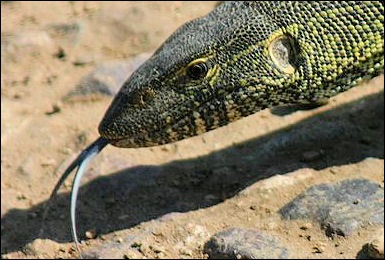
monitor lizard tongue
Monitor lizards are robust reptiles with long, non-autotomous tails. They have nine cervical vertebrae. With the exception of Lanthanotus (Earless monitor lizards) all other lizards have eight or fewer. Their legs often act as heat exchangers. They heat up and cool down faster than the rest of the body and the veins can be enlarged or constricted depending on how much hot or cold blood needs to circulated through the lizard's system. The hemipenes (paired reproductive organs of male lizards and snakes) of monitor lizards are unusually ornate, and have paired apical horns. [Source: Jennifer C. Ast, Animal Diversity Web (ADW)]
All monitor lizards have a tapered head, visible ear openings, a long and slender neck, eyelids, round pupils and powerful jaws. The tail of most monitor lizard species is about two thirds its body length. Unlike most so-called cold-blooded animals, monitor lizards have a high metabolic rate. They burn a lot of energy rapidly. Some species burn up as much energy as mammals. Monitor lizards are nor prey for animals such as leopards because their skin is too thick.
Monitor lizards have long forked tongues that are used for "smelling" and chemoreception. They are similar to but not identical to snakes' tongues. The sense of smell of monitor lizards is so acute they can determine from a long distance whether a snake is poisonous or non-poisonous, or whether another monitor in the area is male or female, resident or nonresident by detecting a few chemicals in the air or by sampling their tracks. Monitor lizards have unblinking eyes and superb vision. They can determine if an object in the sky at a great distance is threatening or nonthreatening. One scientist saw a young monitor lizards tracking a plane traveling at 35,000 feet.
Most lizards can’t breath and run at the same time. The rib muscles which expand the chest during each breath also brace the forelimbs during locomotion, especially running. The peripateric monitor lizards has developed an alternative way for air to reach the lungs when it moves. As the animal moves, specialized bones in its throat depress the throat causing the gullet to expand, creating a cavity for air to be stored in. When enough air flows into the cavity the lizard closes its mouth. Constriction of the throat pumps air into the lungs. The process is repeated the lizard moves..
Venomous Monitor Lizardss
In late 2005, University of Melbourne researchers discovered that all monitors may be somewhat venomous. Previously, bites inflicted by monitors were thought to be prone to infection because of bacteria in their mouths, but the researchers showed that the immediate effects are caused by mild envenomation. Bites on the hand by Komodo dragons (V. komodensis), perenties (V. giganteus), lace monitors (V. varius), and spotted tree monitors (V. scalaris) have been observed to cause swelling within minutes, localised disruption of blood clotting, and shooting pain up to the elbow, which can often last for several hours. [Source: Wikipedia]
University of Washington biologist Kenneth V. Kardong and toxicologists Scott A. Weinstein and Tamara L. Smith have argued that the suggestion of venom glands "has had the effect of underestimating the variety of complex roles played by oral secretions in the biology of reptiles, produced a very narrow view of oral secretions and resulted in misinterpretation of reptilian evolution". According to the scientists "... reptilian oral secretions contribute to many biological roles other than to quickly dispatch prey". They concluded, "Calling all in this clade venomous implies an overall potential danger that does not exist, misleads in the assessment of medical risks, and confuses the biological assessment of squamate biochemical systems".
See Separate Article: KOMODO DRAGON FEEDING: PREY, HUNTING BEHAVIOR AND VENOM factsanddetails.com
Monitor Lizard Behavior
Monitors are diurnal (active during the daytime) and very active period. Unlike other iguanid lizards that are herbivores who leisurely go about their search for food, monitors are active predators who search high and low for their food. They are relatively fast walkers. lumbering along and moving their heads from side to side, flicking their tongues towards the ground to sense for the slightest movements or scents. When they sense something they often freeze like a pointer or some other hunting dog. Males of some species travel over home ranges of ten square miles while females cover about a third of that area.
Monitors are regarded as the most intelligent of all lizards. Monitors in captivity can count to six. Komodo dragons recognize their keepers. In the wild they can remember where hiding places are. If they are threatened they head to these places using the most direct route no matter where they are.
Monitors are good swimmers. They use their powerful tail to propel them through the water. Some have been observed swimming in the ocean, covering distances of 30 or more miles. Mostly they stick to rivers and swamps.
During the dry season when food is much less plentiful, monitor lizards conserve their energy by staying very still. One scientist observed a large male who stayed in a large tree for 72 consecutive days and at most moved from one branch to another. The exception to this is if a monitor lizard finds an abundant food supply and can afford to expend more energy.
Monitor Lizard Feeding Behavior
The eating habits of monitor lizards is diverse, ranging from Gray's monitor, which forages and eats mollusks and fruit, to the Komodo dragon, which is a sit-and-wait predator of large mammals such as deer and wild pigs. Large monitors may also eat carrion. It is said that both Komodo dragons and the water monitors are adept at finding, exhuming, and eating human corpses. [Source: Jennifer C. Ast, Animal Diversity Web (ADW)]
Monitor lizard feed on whatever they can find: insects, snails, eggs, snakes, small lizards, and occasional baby birds or mammals. One species was observed gorging on 100 snails one day, 200 grasshoppers and a four foot snake on other day, in addition to crickets and beetles. Komodo dragons have been known to kill water buffalo. A three-pound juvenile lace goannas (Australian monitor lizards) was observed eating a one-pound rabbit.
Species that feed on eggs buried in tunnels in the ground dig directly down to the eggs rather than try to enter through the tunnel entrance which is often a considerable distance away from the eggs. Other species use their tails to push fish into shallow water where they can pounce on them. Komodo monitors can sense carrion from seven miles away. They have been observed climbing to ridge tops so they can sniff the wind for carrion odors.
Monitor Lizard Hunting
Monitor lizards cover fairly large hunting areas. They feast during the wet season so they have enough stored energy in the form of fat to last through leans times in the dry season, when favorite food such as crickets and beetles are much less plentiful
Monitors are alert and skilled hunters, and this is reflected by their dominance as hunters in many niches across the Old World. They are regarded as skilled and resourceful as many mammal species even though they often rely on completely different mechanism---such as their tongues rather than their noses as sense organs---to find food.
Many species feed primarily on other lizards and these species are often wise to trick of pursued lizards. For example, an escaping lizard often runs in a zigzag pattern to a place such as a bush or rock. Rather than following the lizards zigzag pattern the monitor lizard heads directly to the object the lizard is escaping to and catches it before it arrives. Other lizards escape to a tree by jumping on the tree and then spiral around the to back side, The monitor anticipates this and heads directly to the backside of the tree.
Monitor lizards often catch their prey and then head to some hidden place to kill and consume it. That way they don’t leave themselves exposed and become prey themselves and they don’t give away the places they are most likely to attack. Other lizards don’t do this..
Monitor Lizard Mating
Females often go into estrus for a week or two in the middle of the dry season. This is the only time that males exert themselves as they rush to get at receptive females before the rivals in their home range do. The females are often widely separated. They alert potential male suitors by staking themselves out in a large tree or some other landmark, moving about very little and giving off a pheronome chemical that can be detected up to a mile away.
Males can pursue multiple partners by visiting the home ranges of several females. One small monitor lizard was observed visiting the territory of four females in 45 minutes. Of the females he visited he had mated with two of them already. The hemipenes (paired reproductive organs of male lizards and snakes) of monitor lizards are unusually ornate, and have paired horns at their ends.
Chemical cues play an important role in the ability of males to recognize receptive females. These chemical cues are produced by the female, from glands located in skin of the abdomen. Among Bengal monitors in captivity, females show the greatest chances of successful copulation by mating with only one or two individual males in successive years, though they still may be courted by several other males. [Source: Kathleen Farmer and Eric Wright, Animal Diversity Web (ADW) /=]
Monitor Lizard Eggs and Young
About five weeks after mating female monitor lizards lay 50 one- or two-ounce eggs, usually in underground nests. Having not eaten much for months, she has to reach deep into her fat and nutrients reserves to provide for her young. It is not uncommon for a female to drop in weight from 15 pounds to 9 pounds to after giving birth and incubating the eggs. Some species lay their eggs in termite mounds, They return to the mounds about nine months later to allow the hatchlings to exit.
The eggs incubate for about four months and the hatchlings emerge in the middle of the wet season. Hatchlings have disproportionally large heads. They are wider than the lizard’s body and a quarter of the length of its entire body (excluding the tail). With these configurations it can swallow prey about the same size as itself. Monitor lizards hatchlings are preyed upon by snakes and raptors. They have good vison and a keen sense of smell and can help them stay out of trouble. Still the they have a lot of obstacles to overcome and only about a third of young monitor lizards make it to their first birthday.
According to Animal Diversity Web: In varanid species, the bulk of Parental investment occurs through the materials and energy supplied prior to hatching. This includes resources provided for egg, embryonic, and initial post-hatching development. For example, during embryonic development the yolk supplies the fetus with nutrients required for growth. Females typically create and spend a large amount of time in the nest. She devotes energy to ensuring eggs are protected from predators, such as other monitors, and have proper incubation conditions in order to increase the offsprings' chances of survival. [Source: Kathleen Farmer and Eric Wright, Animal Diversity Web (ADW) /=]
After their lengthy incubation period, however, neonates have very little yolk remaining when they hatch from the egg. This means that new hatchlings must locate food resources quickly and independently. It is interesting to note that females in captivity will frequently retain the eggs longer, spending additional time searching for an appropriate nesting medium. This makes the egg shells thicker than usual. Thicker shells require greater movement and strength on the part of the offspring to break out of the egg. Thus, small yolk food reserves also affect hatchling success. There are no reports showing sufficient evidence that female varanids provide additional care for offspring after laying eggs and hiding them in the nest. In fact, both males and females often eat eggs of other monitors. There also is evidence that females sometimes eat their own eggs. Data suggest that mean egg size and hatchling size are reduced in xeric habitats.
After hatching from eggs, both male and female monitor lizard experience extremely rapid growth up to approximately 12 months. After that initial growth; females tend to stop growing or experience a drastic reduction in growth rate while males continue to grow and develop for several additional months. This results in large size differences between the sexes. Females are thought to experience this early reduced growth because of their sexual maturation and transition from using energy to grow and mature to using energy to prepare for reproduction.[Source: Jillian Krynock, Animal Diversity Web (ADW) |=|]
Earless Monitor Lizards — the 'Holy Grail' of Reptiles
The earless monitor lizard (Lanthanotus borneensis) has been dubbed the "Holy Grail" of herpetology (the study of reptiles and amphibians) because it is so rare and unique. It is the only known member of its family, Lanthanotidae, which means researchers haven't found anything else quite like them living today. The most recent common ancestor of this lizard is thought to have diverged in the Cretaceous period (145 million to 66 million years ago). Their unusual movements and appearance led scientists to speculate that they were a missing link between snakes and lizards — a theory that was later refuted. [Source: Patrick Pester, Live Science, November 4, 2023]
Found only in Borneo, Earless monitor lizards are brown and reach a length of half a meter (1.6 feet) in length and have with slender bodies, tiny limbs and tails that can grasp things. Their heads lack external ears, hence their name. Their their lower eyelids — which they close when underwater — are translucent. Scientists still don't know much about them but much of their external anatomy is suited for a subterranean lifestyle. It is believed they spend their daytime hours burrowing underneath vegetation and rocks on the banks of rocky streams and come out at night to serach for food on land and in the water. Dirt sticks to their lumpy scales, which serves as camouflage. It is hypothesized that they use their tails as an anchor, wrapping them around stones and roots to avoid being swept away in floods. They mate in water, with sessions lasting for hours.
Earless monitors lack of external ear opening. Even though they have ear structures fully developed underneath the skin they do not seem to respond much to auditory stimulus. Jennifer C. Ast wrote in Animal Diversity Web: Its eyes are reduced, as are its nostrils, and it probably relies on its tongue for chemosensory reception as do other members of Varanoidea. Lanthanotus moves through dirt and water with serpentine twisting motions of its trunk, using its blunt head to push aside dirt, and using its rather weak limbs little if at all. Its tail may be somewhat prehensile. Lanthanotus is rather indolent, moving little in captivity, and is apparently nocturnal (active at night). The natural food of Lanthanotus is unknown, although their pointed, recurved teeth hint at small soft-bodied prey. Captive specimens have eaten eggs, worms, and fish. [Source: Jennifer C. Ast, Animal Diversity Web (ADW) /=]
The behavior of Lanthanotus in the wild is very poorly known. Captive specimens have been rather lethargic, although they sometimes struggle energetically when handled and can cling tenaciously to food items. Because of the few numbers of specimens obtained, in the mid-twentieth century it was thought the numbers of Lanthanotus must be very small and they were perhaps on the brink of extinction. More recently it has been thought that there may in fact be many Lanthanotus, but they are so difficult to observe in the wild or collect that their numbers have not been estimated. /=\
Lanthanotidae belongs to Varanoidea, a group comprising Lanthanotidae, the Old World Varanidae, and the New World Helodermatidae. Varanoids in turn belong to the larger group Anguimorpha, which includes such forms as anguids (alligator lizards) and xenosaurids (knob-scaled lizards). Within Varanoidea, Lanthanotus is the sister taxon to Varanidae (Varanus), and is often considered to be a subfamily (Lanthanotinae) within Varanidae. Lanthanotus shares with Varanus the presence of nine cervical vertebrae, paired apical horns in the hemipenes, a smooth, deeply notched, retractile tongue, and several other characters associated with head morphology and musculature. Lanthanotus is distinguished from Varanus by contact of the prefrontal and the postfrontal above the orbits, a vertical suture between the angular and splenial on the medial side of the jaw, broad palatine shelves, and palatine teeth. The only known Lanthanotus-like fossil is Cherminotus, found in Late Cretaceous Period (100 million to 66 million years ago) beds in Mongolia.
Image Sources: Wikimedia Commons
Text Sources: Animal Diversity Web animaldiversity.org ; National Geographic, Live Science, Natural History magazine, David Attenborough books, New York Times, Washington Post, Los Angeles Times, Smithsonian magazine, Discover magazine, The New Yorker, Time, Reuters, Associated Press, AFP, Lonely Planet Guides, CNN, BBC, Wikipedia, The Guardian, Top Secret Animal Attack Files website and various books and other publications.
Last updated August 2025

